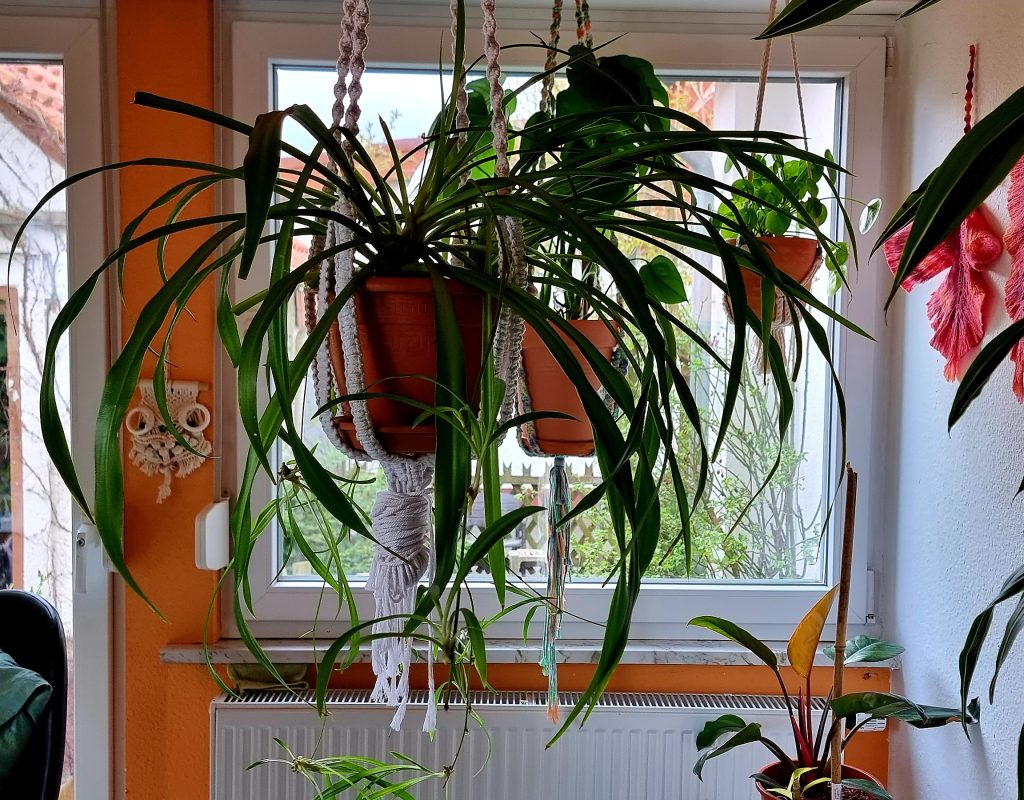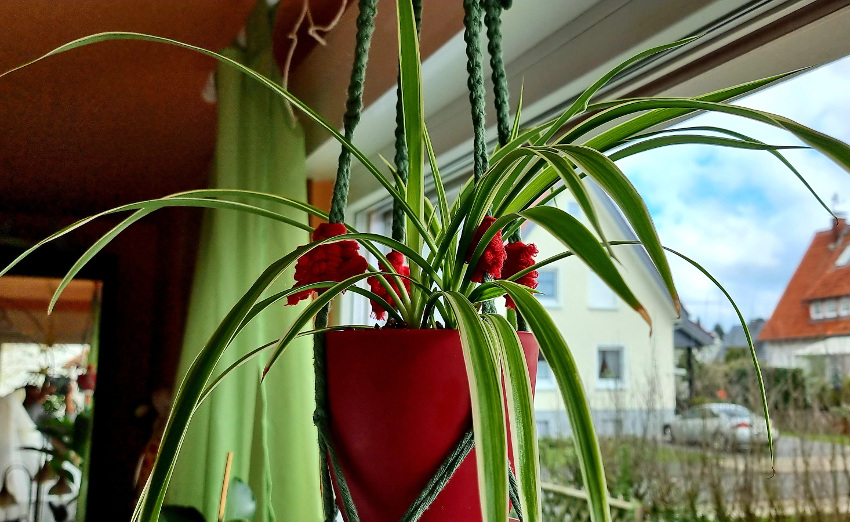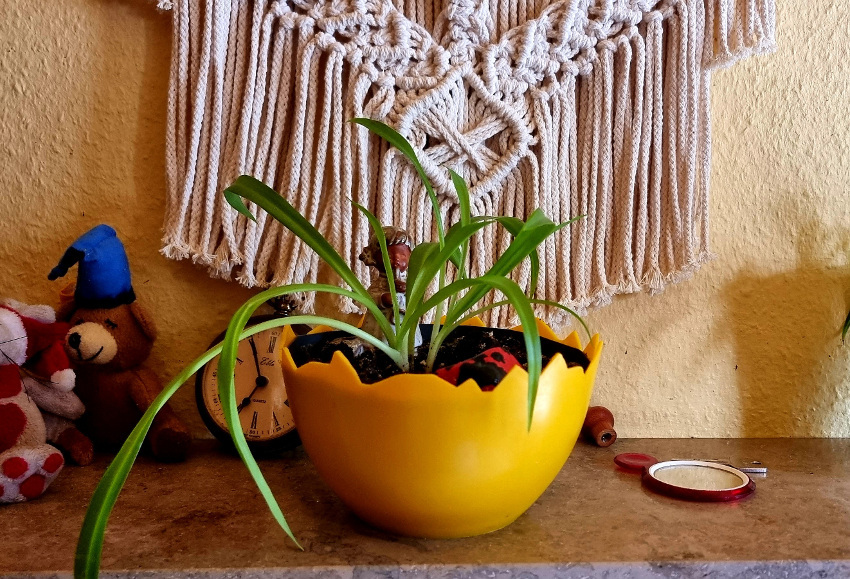Is the hype about the Chlorophytum Comosum (Spider Plant) exaggerated ? Why is everyone raving about it ? Above all, how can you grow and care for Chlorophytum Comosum (Spider Plant)?
In the past, I asked myself the same questions until I made interesting findings through nurturing and growing them.
So if this simple but stunning beauty has captivated you too, I suggest continuing to read to find out more.
Background
Chlorophyntum Comosum is a tuberous plant, commonly known as the Spider Plant and native to tropical Southern Africa. Mature leaves of spider plants can get up to 50cm long and 25mm broad while producing long tubes unto which young plantlets emerge. Their robustness and eye-catching variegations validate them as the perfect plants for offices, beginners, and people on a busy schedule. However, other reasons like their easy care account for why spider plants have stayed trendy over the last years.
So the question is: Are they popular because they’re beginner-friendly, fast growers, inexpensive, tolerant to light frost, and easy to propagate ? Well, maybe !
Furthermore, spider plants are easy to grow, but you have to answer this question based on your experiences and arrive at individual conclusions because it’s a matter of perspective.
However, it’s crystal clear that if you are on a budget and wish to transform your living space into an urban jungle, spider plants will help you easily and quickly reach your goals because they are easy to propagate.
Before we expand on how you can grow and care for your spider plant, it’s vital to know that their care is the same no matter the species. Also, ensure that your cutting or specimen is healthy so that its chance of growing to a mature plant increases.

How to grow and care for the Chlorophytum Comosum (Spider Plant)
Spider plants are undoubtedly beginner-friendly, probably because they tolerate neglect and could effortlessly be acclimated. Still, the fact remains that if you want to grow a robust and healthy plant, placement is everything. Magic happens when your spider plants are placed right !
Where to place your Spider Plant
Additional Care Guide
Frequently Asked Questions
Bonus Tip
Other Species of Spider Plants
Where to place your Spider Plant
Spider plants will grow in low-lighted or poorly lighted rooms but slower and produce thinner leaves than those receiving sufficient light. Fortunately, it’s easy to sort out a suitable space for your spider greenery by knowing where they originate and mimicking the conditions in their natural habitat. As you might have suspected, spider plants are tropical plants, so it’s advisable to follow these rules when sorting out a good spot to place them.
How to position your Spider Plants
- Place your spider plants a meter away from the window or behind a curtain
Spider plants will tolerate poorly lighted rooms, but they will trail and produce countless offsprings when they receive enough light. Also, you’ll be able to tell whether your spider plants are receiving sufficient light or not by the pace at which they’re growing. They will continuously produce spiderettes (young plantlets) which you could decide to propagate or not.
- Bring your plants outdoors in summer
Unlike most houseplants, spider plants are hardy and will not be bothered if you bring them outside during the summer months. If you desire to add a jungle vibe to your patio or terrace, display them in floating baskets or hangers, but avoid placing them in direct sunlight because it will burn their tender leaves.
- Place your spider plants away from your heaters or air conditioners
Spider plants will trail indoors, except for those displayed close to your heaters, because dry air will promote the growth of pests like fungus gnats and spider mites, while cold air from air conditioners will slow down their growth.
Takeaway
Most plants tend to flourish better on Eastern-exposed windows, and your spider plants are no exception. The subtle eastern sunrise provides them with the appropriate amount of light they need for photosynthesis.
Additional Care Guide
Your plant routine should be comprised of:
- Potting spider plants in a well-draining medium
- Watering after performing a control test with your fingers or device
- Misting regularly with Neem oil to keep clean and avoid the growth of pesticides
How to choose a suitable potting medium for Spider Plants
I quote, “Show me your potting medium, and I’ll tell you the fate of your plant.”
I firmly believe that you can successfully grow healthy plants if your planting medium is compatible (hydroponic solutions and well-draining mediums). Nowadays, pre-prepared potting mediums are available at your gardening shops to buy, or you can mix them at home by combining perlite, coarse sand, or mulch to aerate potting mediums to make them well-draining.
My simple potting mix for Spider Plants
My potting mix for spider plants comprises a half-half mixture of perlite and soil but other aerating agents like vermiculite, granulate, and coarse sand will also do the job well.
Although a befitting potting medium is essential for growing a healthy plant, an established watering routine is also vital to your success.
So how do you optimize the watering needs of your spider plant ?
Not just that; how do you establish a simple watering routine ?
You always want to:
- Water your plant after performing a finger control
Proceed by dipping your index finger into the medium as far as it gets, and if it comes out dry, your plant will be welcoming of a drink.
- Use a watering can to disperse the water uniformly
Please always use watering cans because you have more control over the amount of water you disperse.
- Get rid of excess water from your planters
Check your plant vases, catchers, or planters for water deposits and empty them if necessary.
- Create a watering schedule (works best if you have plants of the same species)
You can customize a watering schedule for your spider plants on a calendar by entering the last date you watered, then continue counting until the next watering session. After entering the accurate statistics of your watering routine on a calendar, you’ll never over or under-water your spider plant again. Please note that you will need to adjust your calendar as the seasons change because most plants require more water during the warmer months.
- Switch to rainwater or filtered water
If you notice browning tips on your spider plant, a plausible cause is hard water, which you might resolve by switching to rain or filtered water.

Frequently Asked Questions
Why are the tips of my spider plant turning brown ?
Browning tips in spider plants could be natural and might occur even though you’ve switched to rainwater; why is that so ?
Other reasons may account for the browning tips of your spider plant, such as pests.
Pests like Fungus Gnats are attracted to moist mediums. They will land on your plant, feed on its sap, lay their eggs, and if they go unnoticed, the affected leaf will turn brown and eventually die. The good news is that you can prevent pests by simply misting your plant with diluted neem oil regularly.
- Exposure to direct sunlight
Spider plants grow best in indirect sunlight or filtered light because prolonged exposure to direct sunlight will cause browning tips or burns and eventually loss of leaves.
Help ! My Spider Plants aren’t producing offspring (Spiderettes)
Do you also believe in the saying, ”You get what you paid for ?”
In other words, if you treat your spider plants with care, they will produce baby spider plants non-stop, but if the basics (light, water, fertilizer) are insufficient, your mother plant will not reward you with little ones.
Therefore, if you’re looking forward to some cute spiderettes, show your spider plant some love. 🙂
What am I doing wrong ? My spider plant isn’t growing.
From personal experience, insufficient light is the most probable cause because we also have flourishing spider plants on the eastern-facing window. On the other hand, those on the southern window are marking time which made me conclude that spider plants need ample light to thrive.
I’m on vacation and worried my spider plants might die. How long could spider plants survive without water ?
Spider plants can survive longer without water because of their thick, fleshy roots, able to store water longer than other plants. But for how long could they endure dehydration ?
Well, I wish I could provide a straightforward answer to your question, but it’s impossible because of several factors, like the changing seasons of the year, the growth phases of the plant, and your location, which all play a role in your watering schedules. So, a rough estimation of how long your spider plants could survive without water is 10 – 14 days at the maximum.
Pro-Tip
(You can make use of this tip if you have a few plants and if you are a confirmed gardener)
If your vacation is longer than two weeks, please consider investing in a self-watering device. Most can detect wetness, so you need not worry about over or underwatering anymore.
Additional Tip
Apply liquid fertilizer monthly during the growing seasons to grow healthy spider plants and rescue dying ones. Also, quickly revive them through the Foliar Feeding Method (diluting fertilizer in a spray bottle and misting the foliages of your plants).
When should I repot my spider plant ?
Spider plants are fast-growing plants that appreciate slight rootbound, but these signs should give you a hint about when it’s time to repot.
- An increase in the number of times that you water.
- The roots of the plant will outgrow their catcher or planter.
- You’ll have difficulties inserting your fingers into the medium.
- The growth rate of your plant slows down because of insufficient nutrition in the root-bounded soil.
How to propagate Spider Plants
As an enthusiastic gardener, I have the most fun watching my cuttings develop roots. What about you ? Do you also have fun propagating ?
Healthy spider plants produce long slender tubes unto which young spiderettes emerge. In a few months, the baby spider plants then develop aerial roots that you can grow in soil mediums or hydroponically. Propagating has never been this easy, right ?
Requirements
- A pair of sterile scissors
- A glass of water or potting medium of your choice
Procedure
Select a healthy baby spider plant with mature aerial roots. With your clean pair of scissors, separate it from its tube and place it into your propagation jar or potting medium. Sort out the ideal location and rehydrate it constantly. Give it some care and love, and let it flourish.
Bonus Tip
How to display your Spider Plants
Displaying greenery indoors is beneficial in different ways, but if you are a parent, pet mom, or dad, or you maybe have limited space, it could seem like an impossible task. Let these few tips inspire you and transform your home into a living jungle.
- Display them in mounted plant hangers
- Let them trail from a floating wall shelf
- Use wall planters to showcase your spider plants
- Place them on utilized kitchen or bathroom shelves. The extra humidity will do them good
- Prune down their leaves and display them on your desktop tables

Other Species of Spider Plants
Spider plants exist in non-variegated and variegated forms. The most prominent ones include.
- Bonnie Curly Spider Plant (Chlorophytum Comosum ‘Bonnie’)
- Zebra Grass (Chlorophytum Laxum ‘Zebra’)
- Variegated Spider Plant (Chlorophytum Comosum ‘Vittatum’)
- Variegated Spider Plant (Chlorophytum Comosum ‘Variegatum’)
- Ocean Spider Plant (Chlorophytum Comosum ‘Ocean’)
- Bichetii Grass (Chlorophytum Laxum)
How to grow and care for Chlorophytum comosum (Spider Plant)
References:
Wiki: Spider plants
